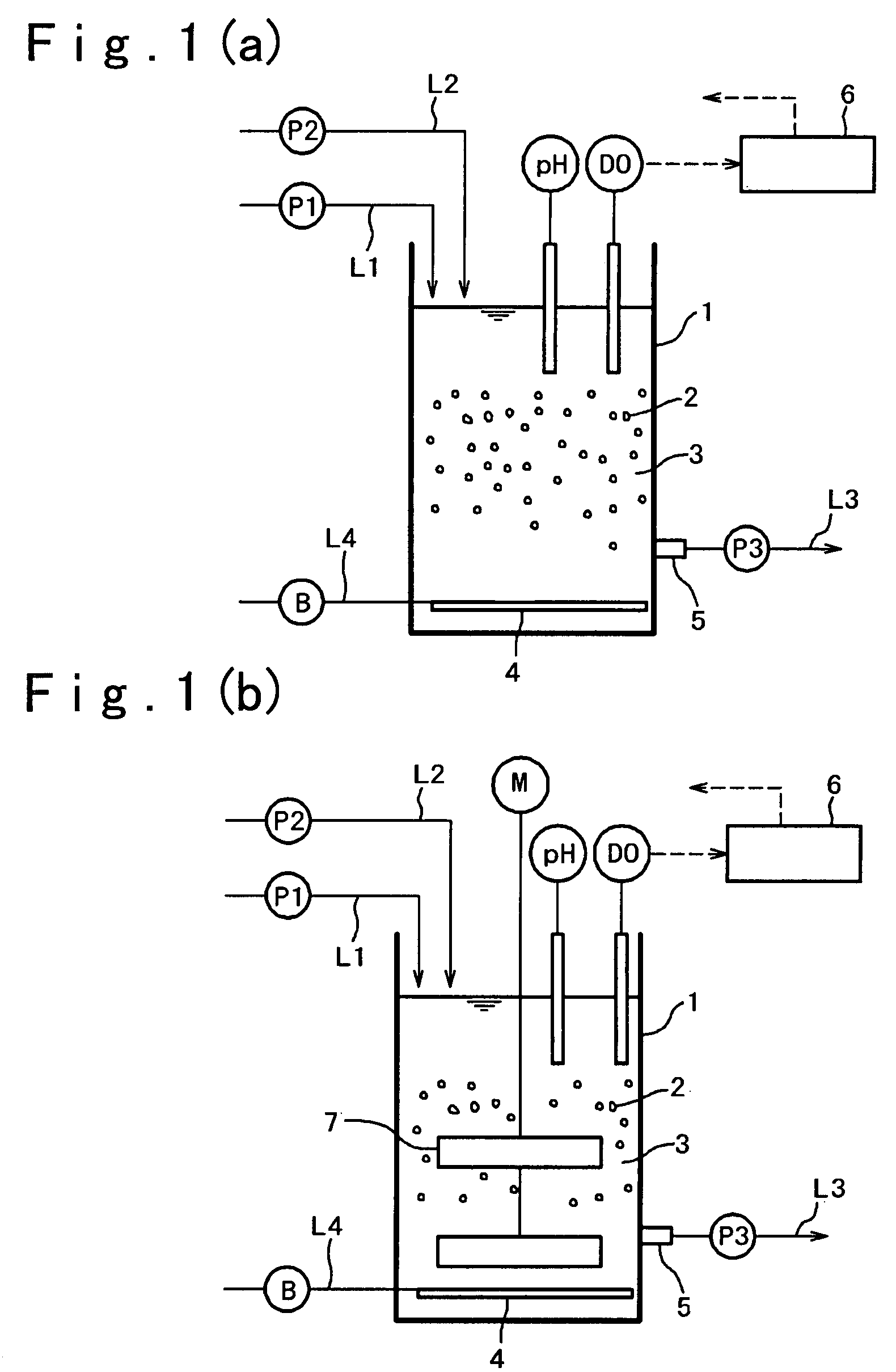Process and Apparatus for Treating Nitrogeneous Liquor
- Summary
- Abstract
- Description
- Claims
- Application Information
AI Technical Summary
Benefits of technology
Problems solved by technology
Method used
Image
Examples
example 1
[0063]Using an apparatus as shown in FIG. 1(a), a microbiological treatment of a influent was carried out by performing the ammonia oxidation and the denitrirification simultaneously. In a reaction vessel 1 of a capacity of 70 liters provided on its side wall at a portion of 3 / 7 of the height of the liquor head in the vessel from the bottom (corresponding to the level of 30 liters of the charged volume) with a delivery port 5, the treatment was effected as follows: As the liquor to be treated, a synthetic wastewater containing an ammonium source of mainly of ammonium sulfate at an ammonium concentration of 100 mg / liter was used. The reaction vessel 1 was equipped with a dissolved oxygen concentration detection device DO and the treatment was carried out while observing the dissolved oxygen concentration of the reaction liquor in the reaction vessel 1. The reaction vessel 1 which stored 30 liters of a biosludge comprising ammonia-oxidizing bacteria and anammox bacteria was charged wi...
example 2
[0069]Using an apparatus as shown in FIG. 1(b), a microbiological treatment of a influent was carried out by performing the ammonia oxidation and the denitrirification in two succeeding steps. In a reaction vessel 1 of a capacity of 70 liters provided on its side wall at a portion of 3 / 7 of the height of the liquor head in the vessel from the bottom (corresponding to the level of 30 liters of the charged volume) with a delivery port 5, the treatment was effected using the same synthetic wastewater as used in EXAMPLE 1 in the manner as follows: The reaction vessel 1 which stored 30 liters of the biosludge comprising ammonia-oxidizing bacteria and anammox bacteria was charged with 22 liters of the synthetic waste water having an ammonium nitrogen concentration of 100 mg / liter and the so-formulated reaction liquor was subjected to aeration in order to cause ammonia oxidation. The reaction liquor was maintained at a dissolved oxygen concentration of 2.0 mg O2 / liter and at a pH value of ...
example 3
[0076]Treatment was carried out as in EXAMPLE 1 followed by adding of an organic substance (methanol) to the reaction liquor after the termination of the ammonia oxidation and the denitrification by anammox reaction so as to reach a BOD value of the reaction liquor of 40 mg O2 / liter, whereupon the resulting mixed liquor was caused to be agitated by a weak aeration for 20 minutes, in order to cause a secondary denitrification by the heterotrophic bacteria. Then, sedimentation of the biosludge flocs was done for three minutes, whereupon 40 liters of the supernatant aqueous phase were discharged out as treated liquor via the delivery port 5.
[0077]The water qualities of the influent and of the effluent are recited in Table 5 below. As seen in Table 5, about 95% of soluble ammonium nitrogen component were able to be removed.
[0078][TABLE 5]
TABLE 5InfluentEffluentN based on NH4100 mg / liter0-2 mg / literN based on NO2—0-2 mg / literN based on NO3—0-2 mg / liter
PUM
| Property | Measurement | Unit |
|---|---|---|
| Fraction | aaaaa | aaaaa |
| Density | aaaaa | aaaaa |
| Density | aaaaa | aaaaa |
Abstract
Description
Claims
Application Information
 Login to View More
Login to View More - R&D
- Intellectual Property
- Life Sciences
- Materials
- Tech Scout
- Unparalleled Data Quality
- Higher Quality Content
- 60% Fewer Hallucinations
Browse by: Latest US Patents, China's latest patents, Technical Efficacy Thesaurus, Application Domain, Technology Topic, Popular Technical Reports.
© 2025 PatSnap. All rights reserved.Legal|Privacy policy|Modern Slavery Act Transparency Statement|Sitemap|About US| Contact US: help@patsnap.com



